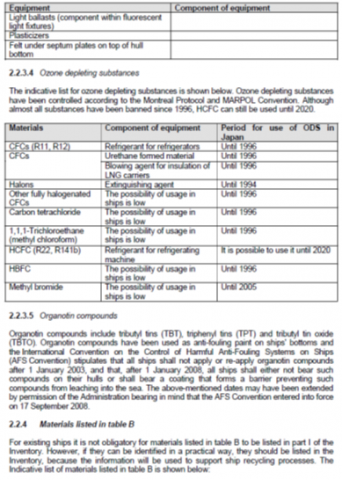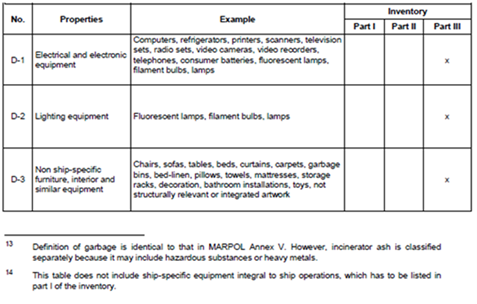FAQ – IHM Regulation

What is IHM?
IHM provides ship-specific information on the actual hazardous materials (HM) presently on board, their location and approximate quantities.
The IHM has following parts:
- Materials contained in ship structure or equipment
- Operationally generated wastes, and
- Stores
IHM Part I
Is the part that has been sampled on your vessel and the Inventory Report has been drawn up, approved and certified. – The Inventory must be maintained and kept up to date during the operational life of the ship.
IHM Part II & III
are only required to be prepared when the ship is decided to be sent for recycling.

Is my Fleet Affected by the EU SRR?
EU SRR is relevant if a ship is
flying the flag of an EU/EEA Member State or if a ship is
flagged under a third country (non-EU) but calls at EU ports or anchorages, provided the ship is operating in marine environment (sea going) and is
equal to or above 500 GT.
How to comply with HKC and EU SRR
for existing ships?
For ships in operation, shipowner is responsible for the IHM maintenance.
An IHM maintenance procedure shall be implemented including
the assignment of a designated person (DP),
by keeping records of changes.
During the IHM renewal survey the following will be checked by the surveyors
Ship’s existing IHM certificate and IHM Part I
updated IHM Inventory (Part I) - together with
maintenance records (i. e. SDoC MD Log)
MDs/SDoCs reflecting the ship’s HM management since last IHM survey
How to Maintain IHM?
Owners must keep the Inventory of Hazardous Materials Part I up to date.
Part I of the Inventory shall be appropriately maintained and updated especially if
any machinery, equipment or component is added
any machinery, equipment or component is removed
any machinery, equipment or component is replaced
hull coating is renewed
MD/SDoC forms provided by the suppliers shall be properly filed and Part I of the IHM shall be updated if any HM (Hazardous Material) has been identified.
Updating is not required if identical parts or coatings are installed or applied where you are already holding the MD/SDoC from former supply or if it has been initially sampled for good.
SDoCs/MDs – for which items?
Detailed requirements can be found
in subsections 4.1.2 to 4.1.4 of the IHM Guidelines (Resolution MEPC.269(68))
Article 5 in EU SRR 1257/2013.
Generally: for IHM Part I items you need an MD. – see your IHM Maintenance Manual and the MEPC.269(68)
IHM Part I items are items which contain:


From experience and interviews indicative lists – see page 30 ff. of MEPC.269(68) - had been developed where different hazardous materials had been found. For these mentioned items you must request a MD - if they are not already mentioned in the Tables C & D.
Please remember:

Indicative lists !






Here are the lists for Part II/III items:
For ship stores as being Part II/III items (to be listed if vessel will be recycled) and which are potentially containing HM (and not being item of Part I, for example paint), such as chemicals, special glues, special sprays etc. you do NOT need a MD – just a MSDS due to safe working practices/procedures - if it is not properly labeled


Table C = Potentially hazardous items
Table D = Regular consumable goods potentially containing hazardous materials, which are not integral to a ship and are unlikely to be dismantled or treated at a ship recycling facility

All other general consumable items and ship stores, which are
NOT going to be fixed to the ships construction or that will
NOT be mounted into any vessel’s machinery equipment
do NOT need any MD! (loosely fitted equipment)
General Exemptions
Materials listed in Table B that consist of solid metals or metal alloys, such as steels, aluminium, brasses, bronzes, plating and solders, provided they are used in general construction, such as hull, superstructure, pipes or housings for equipment and machinery, are not required to be listed in the Inventory.
Although electrical and electronic equipment is required to be listed in the inventory the amount of hazardous materials potentially contained in printed wiring boards (printed circuit boards) installed in the equipment does not need to be reported in the inventory.
Collecting SDoCs/MDs even if not containing HM?
Yes, for the IHM maintenance MDs and SDoCs have to be collected for all the purchased items that are falling into the scope of IHM Part I.
Hong Kong Convention (HKC) and EU Ship Recycling Regulation (EU SRR). HKC Reg 5.3 say that
“Part I of the Inventory of Hazardous Materials shall be properly maintained and updated throughout the operational life of the ship, reflecting new installations containing Hazardous Materials listed in Appendix 2 and relevant changes in ship structure and equipment, taking into account the guidelines developed by the Organization”.
It refers to the MEPC IHM Guidelines. And MEPC IHM Guidelines 4.1.4 say
“The checking of materials as provided in paragraphs 4.1.2 and 4.1.3 above should be based on the Material Declaration furnished by the suppliers in the shipbuilding supply chain”.
The SDoCs/MDs -even if NOT containing HM- have to be kept available at all times.
PSC Measures for Inspecting IHM
The PSC shall be limited to verifying that
Øeither an IHM Certificate or a
ØReady for Recycling Certificate is on board,
both supplemented by the verified IHM, which, if valid, shall be accepted for the inspection.
A Detailed Inspection may be carried out when:
a ship does not carry a valid certificate or
there are clear grounds for believing that:
- the condition of the ship or its equipment does not correspond substantially with the particulars of the certificate, and/or IHM Part I; or
- there is no procedure implemented on board the ship for the maintenance of IHM Part I.
Worst Case Scenario:
A ship may be
warned,
detained,
dismissed or
excluded
from the ports or offshore terminals under the jurisdiction of a Member State
A Member State taking such action shall immediately inform the administration (Flag State) concerned.
Failure to update the IHM shall not constitute a detainable deficiency, but any inconsistencies in the IHM shall be reported to the administration concerned and shall be rectified at the time of the next survey.
When shall the IHM Part II & III be prepared?
1.IHM Part II operationally generated wastes and
2.IHM Part III stores
shall be prepared by the shipowner once the decision is given to send the ship for recycling.
I.The IHM Part II and III can be prepared by the crew or if shipowner prefers a hazmat expert can also prepare it.
II.For IHM Part II & III preparation, please refer to MEPC.269(68) IHM Guidelines as below:
a.Refer to 4.4 & 4.5 in Annex 17, page 8 for IHM Part II & Part III development requirements;
b.Refer to Table C and Table D in Annex 17, page 14 & 15 for the potentially hazardous materials;
c.Refer to the IHM Part II & III example table in Annex 17, page 18-21;
d.Additionally, IHM Part II & III investigation report with supporting documents, such as inventories, recordings, logbooks, site pictures, etc. attached as the appendices should be provided to DNV GL for approval.
Asbestos on Board
General:
For ships built between 1 July 2002 and 1 January 2011
For all ships, new installation of materials which contain asbestos shall be prohibited except for:
- vanes used in rotary vane compressors and rotary vane vacuum pumps;
- watertight joints and linings used for the circulation of fluids when, at high temperature (in excess of 350ºC) or pressure (in excess of 7 x 106 Pa), there is a risk of fire, corrosion or toxicity;
- and supple and flexible thermal insulation assemblies used for temperatures above 1000ºC.
For ships built after 1 January 2011
The 2009 Amendments to SOLAS (resolution MSC.282(86)), further amended the text to prohibit all new installation of asbestos on board ships. These came into force on 1 January 2011;
IMO MSC.1/Circ.1374, Article 13 reads as follows:
“When asbestos is detected on board, in contravention of SOLAS regulation II-1/3-5, action should be taken to have it removed. The removal – assigned to professional asbestos removal companies – should take place within a time frame of 3 years from the date when the contravention is found and should be conducted in close consultation with and, where applicable, under the supervision of the Flag State concerned. In such cases, a suitable exemption certificate should be issued by the Flag State.”
If Asbestos is detected on board, it may affect Safety Construction Certificate of the ship according to SOLAS requirement. Shipowners shall notify the flag state, and flag state would either decide to issue an exemption certificate or would give a time frame to the shipowners to remove the asbestos according to MSC/Circ.1045. Flag has the final say.
ACTIONS to be taken:
Vessels Command
Asbestos Management Plan (AMP) from shipowner - all asbestos findings have to be inserted to have an Asbestos Management Register as per IHM Inventory & periodically surveillance
Risk Assessment according ISM/flag state requirements
Familiarization of Crew
Marking of asbestos containing items with asbestos sticker provided by the company
Shipowner
o Asbestos Exemption Certificate from Flag State to be applied
o A special Personel Protective Equipment (PPE) Box will be sent to the vessels
o Asbestos Stickers to be sent to the vessels
o PIC for asbestos and Inspection Team will discuss further actions concerning removal etc. with the flag states and vessels command – IHM Dept. to be kept in copy for information.